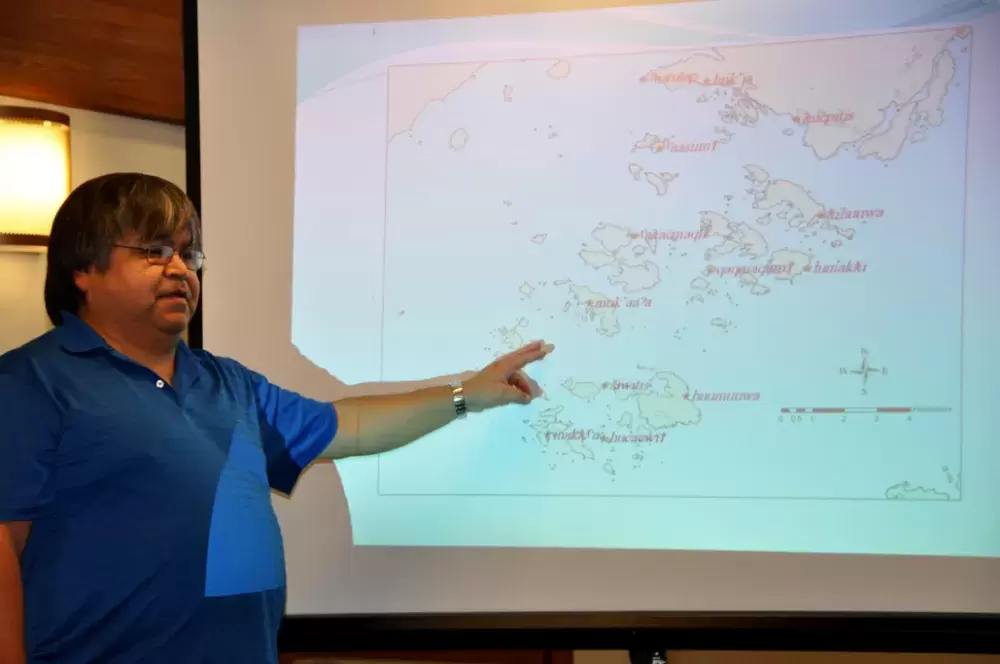Members of Tseshaht First Nation attended a workshop on Dec. 12 to initiate development of a Tseshaht Google atlas, incorporating cultural, geographical and historical information in a user-friendly package.
Darrell Ross, research and planning manager for Tseshaht, said the goal is to take both traditional and technical knowledge and make them available online, both to members and to the public, “To tell the story of who we are as Tseshaht – what our resources are, where we have lived and where we will live.”
Members were asked to consider what vision the Tseshaht atlas should present to the world, and to consider the implications of opening up cultural information and resources, some of it sensitive, to anyone with an Internet browser.
The meeting began with a Powerpoint presentation from Peter Waardenburg of the Okanagan Nation, who has been perfecting a Google Earth-based program, Voices on the Land, over the past four years.
Waardenburg was accompanied by Sue Hanley, coordinator of the First Nations Technology Council (FNTC), which will fund the Tseshaht project.
Waardenburg said the Voices on the Land Web site was designed as a land-use planning tool, but its potential is almost limitless.
“The applications you can use it for are so far reaching. We have only reached the tip of the iceberg as to what this tool can do,” he said.
One of those capacities is the ability to provide detailed information by timeline, by selecting a decade from the 20th or 21st centuries.
“We have a number of key themes: land, culture and water,” Waardenburg explained.
By bringing up the available data on forest harvesting activity, for example, the Okanagan Nation can evaluate the value of timber extracted from its traditional territories, decade by decade, he explained. Or with the click of a mouse, draw up the database on the mountain pine beetle infestation, current and historical oil and gas exploration, mining activity and agricultural land reserve lands.
“It allows people to comprehend the level of resource extraction on our land base,” Waardenburg said.
Another feature, this one in the cultural area, is the growing collection of short videos on traditional place names within the Okanagan Nation traditional territory.
“We’ve built in an application on top of Google Map,” Waardenburg said, launching a YouTube video with an elder explaining the significance of Spotted Lake. “That’s one of our place names, out of 144 that we plan to do.”
Waardenburg pointed out, however, that Okanagan Nation elders have final say over whether place name information can be made public. As in Tseshaht traditional territory, many Okanagan Nation cultural sites are protected.
Hanley said a security tool could be designed to allow different levels of access within Tseshaht, versus the general public.
“You can put what you want the world to know about Tseshaht,” Hanley said. “There has already been a suggestion that, when you enter into this area, your GPS will say, ‘Welcome to Tseshaht territory’ in your own language.”
First Nations Wildcrafters co-owner Keith Hunter pointed out that some land base information is proprietary, such as the location of non-timber resources like mushrooms, berries and herbs.
“It may be appropriate to include specific knowledge, such as the location of berry patches, for Tseshaht planners, but not for the general public,” Hunter said, adding that the information would be critical in planning things like roads and rights-of-way, in order to protect valuable resources.
Ross said much of the knowledge has already been compiled, and the task will be to create a Web site that is accessible and appealing to tech-friendly youth.
“We have been doing GIS [geographic information systems] work for 15 years, but really detailed stuff, the past eight or nine. We have compiled a lot of data,” Ross said. “We have close to 1,200 sites in our territory that are GIS mapped.”
Those include habitation sites, spiritual sites, archaeological sites, resource sites, shellfish sites – even “supernatural being” sites in Barkley Sound, Ross said.
“Because we have so much data, we can articulate it in many ways,” he said. “We have a lot of information, but we need to look at how we will share it.”
Security was a theme raised by a number of members, and there was general agreement that the site must be layered and password-protected for information sensitive both for the nation and for families and individuals.
In that area, First Nations Wildcrafters co-owner Anne Robinson suggested the Makah First Nation Web site, which provides family-based security layers. It could serve as a model while, as husband Keith advocated, the main atlas site would be built on a Google Earth platform using Voices on the Land as a template.
“Tseshaht won’t have to re-invent the wheel,” he said.
In turn, Waardenburg said he and his nation would freely share their technology and experience with Voices on the Land.
Hunter said the atlas project came about when the FNTC put out a call for expressions of interest, “And we got picked.”
Hanley said the council has funding to get the project online, but it must move fairly quickly.
“We are supposed to have the project finished and implemented by March 31,” she said, adding, “But that just means creating a first layer and getting it online.”
Hanley said there is sufficient data in the Tseshaht system to move forward while the main Web site is in the design process.
Members resolved to set up a community consultation process to determine the vision that will govern the Tseshaht atlas project. The first step will be to assemble a working group. A meeting will be scheduled for some time in mid-January.







